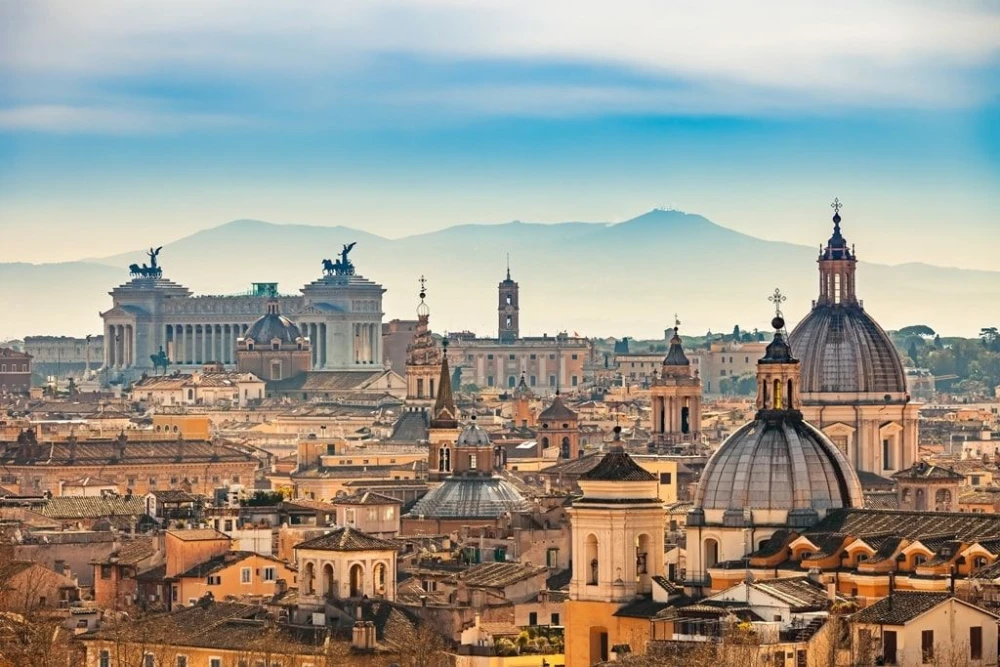15124, Maroysi, Athens, Greece
Civitavecchia (Rome), Livorno (Florence, Piza), Portofino, Barcelona, Cartagena-, Malaga, Cagliari, Palermo


Our gateway to the Eternal City, Civitavecchia has served as Rome's seaport since the 13th century, boasting a long and venerable history. Its location near the modern city, made it a perfect vacation resort for emperor Trajan, who built a pleasure villa. while Bernini and Michelangelo designed the harbor fortifications. Yet the Eternal City, the ancient capital of the Western World and the center of Christianity for nearly 2.000 years, is our main reason to be here. YYou can visit the ruins of the Forum and the Colosseum, throw a coin in Fontana di Trevi to make sure you return to Rome one day, take a photo in front of the Vatican, view the splendors of the Sistine Chapel or climb the Spanish Steps, once the heart of Rome's Bohemian Quarter and enjoy a delicious gelato, in the glamorous area.

Livorno, Tuscany's second-largest city, is the maritime gateway to the Tuscany region and its two most known cities, Florence (to the west) and Pisa (to the north). Among Livorno's main attractions are the Cisternone, an impressive neoclassical building on Viale Giosue Carducci, designed like a Roman bath, the main city square Piazza della Repubblica with Fortezza Nuova (the castle dating back to around 1576) in the background and a number of interesting shops in the city centre that visitors can explore. Florence, the cradle of the Renaissance, is home to the Duomo, the Uffizi and the Ponte Vecchio. Pisa contains a host of beautiful cathedrals, palaces and bridges over the Arno River, as well as its glorious Leaning Tower, monument to faulty engineering.
Portofino is an Italian resort, located on the Italian Riviera, famous for its picturesque harbor with the colourfully painted buildings. It is the favorite destination of many celebrities and artists.

Barcelona is one of the world's greatest treasures, a global capital of commerce, fashion, culture and sunshine. Cruise visitors should start with a walk down Las Ramblas, the glorious tree-shaded thoroughfare at the heart of the city, enjoy a dive in the wonderful beaches nearby, but, most of all, see what visionary architect Antoni Gaudi wrought. Seven of his creations have been honored as UNESCO World Heritage Sites, including La Sagrada Familia, the Park Guell and Casa Mila. Time provided, you can also visit the former Olympic Ring on the hill of Montjuic, home to world-class parks, fountains and museums. Barcelona, which nurtured such artistic giants as Picasso, Dali, Miro and Casals, is definitely a traveler's paradise.
Cartagena is major naval station located in south-eastern Spain, in the autonomus Region of Murcia. Since its foundation in 229 B.C, it has been inhabited by several cultures which have left their mark on its artistic heritage as one of the most important defensive ports in the country. The highlights of the city include the Muralla del Mar ('Sea Wall'), built by Charles III (18th century), the Old Cathedral located on the Camino del Parque Torres (behind the Muralla del Mar wall), the recently restored Roman Theatre (among its numerous other Roman remains, built between the 5th and 1st centuries BC), the National Museum of Underwater Archaeology ARQUA (at Paseo Alfonso XII, 22), the Town Hall, a gem of modernist architecture dating from the early 20th century and a number of modernist buildings made for its military fortifications. The best way to learn more about the Modernist architecture of Cartagena is to take a walk along the Calle Mayor, which leads off the Plaza del Ayuntamiento square. Here visitors will find the houses of Cervantes and Llagostera, by the Cartagena architect Victor Beltrí. Time given, don't miss Concepción Castle, built on one of the five hills of the old Carthagena and today home of the Centre for the Interpretation of Cartagena's History.
The southernmost large city in Europe, lies on the Costa del Sol (Coast of the Sun) of the Mediterranean, about 100 km east of the Strait of Gibraltar and about 130 km north of Africa. Málaga's history spans about 2.800 years, making it one of the oldest cities in the world. The walls of the Phoenician city are visible in the cellar of the Museo Picasso Málaga. The best-preserved Moorish citadel in Spain is located next to the Roman theater, which which dates from the 1st century BC and was rediscovered in 1951. The nearby caverns of Nerja provided refuge to humans 30,000 years ago and is a must-visit tourist attraction. Cruise guests can visit the old castles, the museums and the beaches or enjoy the scenery, sipping a Malaga sweet wine, accompanied with a plate of tapas.
Cagliari, the capital of Sardinia, spreads on a hillside overlooking the aptly named Gulf of Angels. Visit the old Castello Quarter, with the narrow and shaded streets and the old buildings, or enjoy the wide and expansive beaches of Sardinia, basking in the Mediterranean sun. All over the island, there are traces of ancient settlements, such as neolithic ruins at Nora; Phoenician, Cathaginian and Roman relics near Cagliari; and Arab, Genoese and Iberian heritage evident in architecture dating back to the Middle Ages.

Palermo, capital of Sicily, is situated right by the Gulf of Palermo in the Tyrrhenian Sea. Traces of Roman, Arab and Norman influences mix here, in a city that is over 2.700 years old. The highlights of Palermo, which is noted for its history, culture, architecture and gastronomy, are Palazzo dei Normanni, one of the most beautiful Italian palaces and a notable example of Norman architecture with its golden Byzantine mosaics, the Cathedral with the heliometer (solar "observatory") of 1690, Santa Maria dell'Ammiraglio (St Mary of the Admiral), San Giovanni degli Eremiti (12th century), Palazzo Abatellis with the Regional Gallery, the Regional
Archeological Museum Antonio Salinas, the neoclassic Teatro Massimo ("Greatest Theatre",1897) and many
small piazzas that depict the city's historic past.

Our gateway to the Eternal City, Civitavecchia has served as Rome's seaport since the 13th century, boasting a long and venerable history. Its location near the modern city, made it a perfect vacation resort for emperor Trajan, who built a pleasure villa. while Bernini and Michelangelo designed the harbor fortifications. Yet the Eternal City, the ancient capital of the Western World and the center of Christianity for nearly 2.000 years, is our main reason to be here. YYou can visit the ruins of the Forum and the Colosseum, throw a coin in Fontana di Trevi to make sure you return to Rome one day, take a photo in front of the Vatican, view the splendors of the Sistine Chapel or climb the Spanish Steps, once the heart of Rome's Bohemian Quarter and enjoy a delicious gelato, in the glamorous area.
Itinerary







